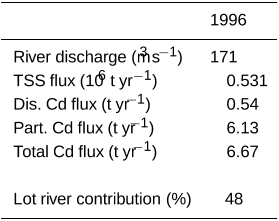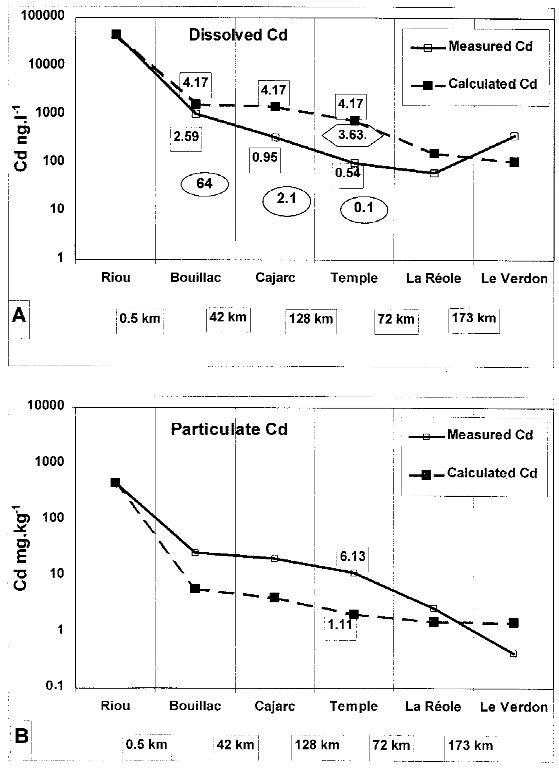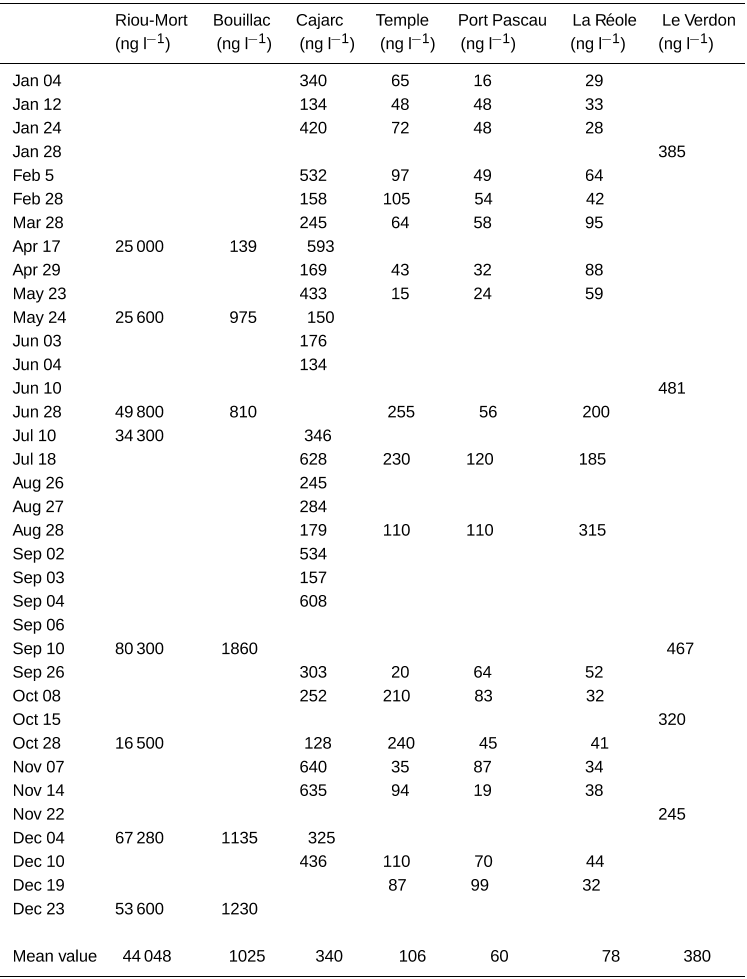
Hydrobiologia 410: 331–341, 1999.
J. Garnier & J.-M. Mouchel (eds), Man and River Systems.
© 1999 Kluwer Academic Publishers. Printed in the Netherlands.
331
A cadmium budget for the Lot-Garonne fluvial system (France)
G
´
erard Blanc, Yvon Lapaquellerie, No
`
ele Maillet & Pierre Anschutz
D´epartement de G´eologie et Oc´eanographie (D.G.O.), Universit´e Bordeaux 1, UMR CNRS 5805 EPOC., Avenue
des Facult´es, 33405 Talence cedex, France
E-mail: blanc@geocean.u-bordeaux.fr
Key words: pollution, cadmium budget, Lot-Garonne rivers
Abstract
Routine measurements of river discharge and total suspended sediment concentration (TSS) are combined with
regular analyses for particulate and dissolved cadmium to produce a box model that allows us to propose a cad-
mium mass balance for the Lot-Garonne man-influenced river system (8400 km
2
). Nearly half the cadmium in the
Garonne river is supplied by the tributary Lot river. Cadmium input onto the Lot river comprises wet deposition
from the atmosphere, molecular diffusion at the sediment-water interface, surface-water runoff and discharge from
the leaching of waste at a zinc refining plant. Approximately 85% of the cadmium in the Lot river is derived from
anthropogenic origin. Cadmium in the industrial discharge is 80% dissolved and 20% in the particulate phase (4.2
and 1.1 t yr
−1
, respectively). Total inputs are estimated at 4.81 t yr
−1
and 1.54 t yr
−1
for the dissolved cadmium
and for the particulate phase, respectively. Budgeting estimates an output onto the Garonne river of 0.54 t yr
−1
for the dissolved cadmium (about 8%) and 6.13 t yr
−1
for the particulate cadmium (about 92%) indicating that
downstream sediment-associated cadmium fluxes are enhanced by the 4.27 t yr
−1
removed from solution and the
0.32 t yr
−1
remobilized by the erosion of sediment blanketing the Lot river bed. These figures are found to be
comparable with those generated by a dilution model which suggests that 97% of dissolved cadmium is taken up
by the particulate phase over 0.5 km downstream from the primary anthropogenic source.
Introduction
Although the Aquitaine basin is one of the least indus-
trialised regions in France, the Lot-Garonne-Gironde
fluvial system can be considered as a natural model for
pollution in non-ferrous metals such as Cd, Zn, Ba, As
(Roux & Simonet, 1987). Historically, chronic pollu-
tion has resulted from industrial and mining activities
that started to develop in the late nineteenth century
and in particular, cadmium, which has a high toxicity
for biota, is considered as the major polluting metal
of this fluvial system. Cadmium pollution was first
recognised in 1979 within the framework of the ‘Na-
tional Observation Network’ (Latouche, 1988) which
documented the high cadmium content in the flesh of
the Gironde oysters (up to 100 µgg
−1
of dry matter).
These concentrations are 10 times higher than those
typically found in oysters from French non-industrial
areas (Boutier, 1981) and reflect the high kinetics ac-
cumulation in oysters. As oysters are very sensitive
to this pollution, the Marennes-Oleron oyster farming
located ca. 30 km to the north of the mouth of the
Gironde estuary is considered at risk (Jouanneau et al.,
1993).
The primary source for present day cadmium pol-
lution is probably attributed to leaching from the waste
area of a now abandoned zinc ore manufacturing facil-
ity (Latouche, 1992). This plant was founded in 1840
and is located near Decazeville, a town on the Riou-
Mort that tributes to the Lot river ca. 200 km upstream
from the Lot-Garonne confluence. However, several
large hydroelectric dams which were built from 1945
to 1960 in the upper reaches of the Lot valley, together
with the 62 smaller storage structures located down-
stream from the Riou-Mort confluence, decrease the
magnitude of winter and spring floods (Massio, 1976).
This has resulted in significant sediment and cadmium
accumulation in the lower reaches of the Lot river.
Lapaquellerie et al. (1995) estimated that 0.47 ± 0.9
× 10
6
m
3
of sediment and about 200 tons of cadmium

332
accumulated in the Lot valley between the Riou-Mort
and Garonne river in 1991.
This paper aims to establish a macroscopic de-
scription of cadmium behaviour in the Lot-Garonne
fluvial system (8400 km
2
) by using the annual (1996)
flux of both the particulate and dissolved phases. By
quantifying the contributions from the primary source
(i.e. the Riou-Mort river) and the secondary source
(i.e. the sediment-associated cadmium in the Lot
river), together with internal transfert processes and
the overall output, we propose a tentative cadmium
budget for the Lot-Garonne study basin.
Sampling and methods
Because the Lot river is the major polluting tributary
of the Garonne, and then of the Gironde, it was neces-
sary to obtain a representative estimation of its total
suspended sediment (TSS) fluxes. This was accom-
plished using a total of six sampling sites (Figure 1).
Samples from Temple (Lot) were collected automatic-
ally using a Buhler PB-MOS sampler, whilst samples
from the five remaining sites were collected manually.
The automatic sampler collects a daily cumulative 1
l sample consisting of 16 elementary samples. The
frequency of TSS measurements and analyses for par-
ticulate and dissolved cadmium is reported in Table 1.
Transverse and depth profiling was undertaken to test
the representativeness of our local sampling at Temple
and La Reole sites (cf. Lapaquellerie et al., 1996).
At both sites, these tests showed that variations in
TSS concentrations due to depth and distance from
the bank did not exceed 6% and 2.3% during flood
and base flows, respectively. TSS concentrations were
determined using filtration (Whatmann GF/F, 0.70 µm
filters) and each sample set typically showed a stand-
ard deviation of 1.5% about the mean. The annual
mean values of the TSS concentrations for each site
are reported in Table 2.
The mean annual discharge (1996) for the Lot
and Garonne rivers was calculated using the daily
measurements undertaken by the autonomous port of
Bordeaux and the hydrological office of Toulouse (see
Table 2). The precisionis generallyabout5% for water
flows higher than 40 m
3
s
−1
.
Sediment-associatedcadmiumconcentrationswere
determined from bulk suspended sediment samples re-
trieved by centrifuging between 500 and 1000 l of
water using a Wesfalia separator. The cadmium con-
tamination from this equipment is much less than
the analytical error which is about 5% (Etcheber &
Jouanneau, 1980).
The water samples were collected and filtered for
cadmium analyses using a clean technique. Surface-
water samples were taken from a small rubber dinghy,
by immersing a teflon sampler specially designed to
avoid any contact with the atmosphere. This sampler
holds a 100 cm
3
acid-cleaned polypropylene vial.
The water samples were immediately filtered through
acid-cleaned (Ø 47 mm diameter, 0.45 µm pore-size)
Nuclepore polycarbonate membranes.
Triplicate analyses for the particulate and dissolved
cadmium concentrations of individual samples were
undertaken using a graphite furnace atomic absorption
spectrometer. Particulate cadmium analyses required
the complete dissolution of individual dried solid
samples. The total digestion used by this study in-
volved the dissolution of 30 mg of each sample in 750
µl HCl (12N), 2 ml HF (26N) and 250 µl HNO
3
(14N)
in small Teflon bombs. The bomb were then heated at
110
◦
C for 2 h, and after cooling, the digested solution
was evaporated to dryness and the residue dissolved in
150 µl concentrated HNO
3.
Each sample was left on
a hotplate until the residue was completely dissolved
and then brought to 5 ml in a volumetric flask using
double-deionized water. Prior to the determination of
dissolved cadmium content, the samples were precon-
centrated in a class 100 clean room by complexating
with ammonium pyrrolidine dithiocarbamate/ diethyl-
ammonium diethyl dithiocarbamate (APDC/DDDC),
extracting into freon and back extracting with HNO
3
into deionized water (Danielsson et al., 1982). In the
Riou-Mort tributary, dissolved concentrations were
high enough to be analyzed directly, without precon-
centration. Accuracy of the analyses was determined
by comparisons to river sediment (CRM320) and wa-
ter (SLRS3) international standards, and was within
5% for cadmium. The precision of the analyses, as
determined from duplicate samples was generally 5%
for cadmium at concentrations 10 times higher than
the detection limit. The content of cadmium in solid
phases is given in milligrams per kg, whereas the dis-
solved cadmium content is given in nanograms per l.
The results of the cadmium analysis for 79 suspended
sediment and 99 water samples collected during year
1996 are reported in Tables 3 and 4.
Results
River discharge, total suspended sediment (TSS) and
cadmium concentrations are the major parameters for

333
Figure 1. Sampling locations in the Garonne river, Lot river, and its tributaries (Riou-Mort, C
´
el
´
e), and also at the Verdon (estuary mouth).
Table 1. Location and sampling frequencies for the study sites, x and y are the coordinates in Lambert III projection, South
Area
Sites Map Location Sampling Sampling strategy
x / y Type TSS dis.Cd part.CD
Riou-Mort IGN 2238 W 560.05 / 3241.09 manual 8 yr
−1
8yr
−1
8yr
−1
Bouillac IGN 2338 589.00 / 3253.45 manual 8 yr
−1
6yr
−1
5yr
−1
Cajarc IGN 2238 W 560.05 / 3241.09 manual 5 yr
−1
39 yr
−1
5yr
−1
Temple sur Lot IGN 1839 W 453.55 / 3234.00 Automatic sampler 365 yr
−1
18 yr
−1
18 yr
−1
Port Pascau IGN 1739 E 439.07 / 3323.00 manual 365 yr
−1
18 yr
−1
18 yr
−1
La R´eole IGN XV-37 (3–4) 374.22 / 280.20 manual 365 yr
−1
18 yr
−1
18 yr
−1
Le Verdon IGN XIV-33 (1–2) 334.62 / 62.18 manual 4 yr
−1
5yr
−1
6yr
−1
the estimation of dissolved and particulate matter
fluxes. The riverdischarge can vary by factorsof about
45 and 30 for the Garonne and Lot rivers, respectively.
At the beginning of a flood such maximum changes in
river discharge can usually be observed during a single
day. In addition, the TSS concentrations change by a
factor greater than one thousand between the flood and
the lowest water level periods. At La Réole, the TSS
concentration reached up to 1300 mg l
−1
in Decem-
ber, whereas it fell down to 0.3 mg l
−1
in September
(Table 2). The annual mean value of TSS concentra-
tion varies spatially, increasing from 25 mg l
−1
the
Riou-Mort to 110 mg l
−1
Cajarc. Conversely, the TSS
concentration at Temple shows an annual mean value
of 98 mg l
−1
. This lower value probably results from
the settling of the suspended sediment into the nu-
merous reservoirs. In 1996, the TSS concentration at
Port-Pascau (Garonne) was approximately twice that
of the downstream Lot. The changes in concentration
of the particulate and dissolved cadmium show a tem-
poral variability less than that of TSS concentration.
Thus, it was not necessary to collect a sample every
day, although the floods were sampled.
In 1996, the mean particulate cadmium concentra-
tions decreased progressively from 460 mg kg
−1
at
the Riou-Mort to 12.5 mg kg
−1
at Temple (Table 3).
They were 10 times lower at Port-Pascau, and,
consequently, a mean cadmium concentration of
2.6 mg kg
−1
was determined at La Réole, downstream
of the junction of the Lot and Garonne rivers. Because
of the chlorinity increases in the Gironde estuary, the
particulate cadmium concentrations reach a minimum
mean value of 0.43 mg kg
−1
at Le Verdon. The mean
particulate cadmium concentration of 2.59 mg kg
−1
,
determined in 1996 at La Réole, is comparable to
that given by Elbaz-Poulichet (1988) for the Rhône
river, and that given by Chiffoleau et al. (1997) for
the Seine river (i.e. 2.8 mg kg
−1
), but much lower the

334
Table 2. 1996 mean, maximum and minimum values for river discharge (m
3
.s
−1
) and TSS concentration (mg.l
−1
) at each sampling
site
Riou-Mort Bouillac Cajarc Temple Port Pascau La R´eole Le Verdon
mean 3 80 89 171 637 808 1200
River discharge (m
3
s
−1
) max 35 431 480 922 3523 3928 4748
min 8 18 22 30 32 85 170
mean 25.4 99.9 110.4 98.5 207.4 182.9 151.9
TSS (mg l
−1
) max 81 196 205 390 1105 1297 313
min 13 45 10 6 0.2 0.3 35
Table 3. Particulate cadmium concentrations determined at each site in 1996
Riou Mort Bouillac Cajarc Temple Port Pascau La R´eole Le Verdon
(mg kg
−1
) (mg kg
−1
) (mg kg
−1
) (mg kg
−1
) (mg kg
−1
)(mgkg
−1
) (mg kg
−1
)
Jan 04 11.3 0.69 2.53
Jan 12 15.2 0.34 2.34
Jan 24 16.1 0.33 1.91
Jan 28 0.56
Feb 5 15.9 0.74 1.47
Feb 28 12.3 1.32 1.58
Mar 28 10.4 1.24 2.34
Apr 17 484 17.3 23.1
Apr 29 16.0 1.2 3.6
May 16 0.94
May 23 10.8 1.31 3.52
May 24 504 29.3 17.1
Jun 10 0.48
Jun 28 767 7.7 1.59 2.34
Jul 10 350 22.5 26.7
Jul 18 8.1 1.69 2.45
Aug 28 13.6 1.39 2.33
Sep 02 244
Sep 06 0.21
Sep 10 689 29.9 21.7
Sep 26 16.9 1.67 3.02
Oct 08 16.9 2.29 3.8
Oct 15 0.18
Oct 28 286 10.2 2.56 2.22
Nov 07 7.4 1.15 3.3
Nov 22 12.1 1.86 2.01 0.21
Dec 04 386 33.1 14.5
Dec 10 14.6 2.44 3.1
Dec 19 9.4 2.13 2.17
Dec 23 432
Mean value 460 26.4 20.6 12.5 1.44 2.59 0.43

335
Table 4. Dissolved cadmium concentrations determined at each site in 1996
Riou-Mort Bouillac Cajarc Temple Port Pascau La R´eole Le Verdon
(ng l
−1
)(ngl
−1
)(ngl
−1
)(ngl
−1
)(ngl
−1
)(ngl
−1
)(ngl
−1
)
Jan 04 340 65 16 29
Jan 12 134 48 48 33
Jan 24 420 72 48 28
Jan 28 385
Feb 5 532 97 49 64
Feb 28 158 105 54 42
Mar 28 245 64 58 95
Apr 17 25 000 139 593
Apr 29 169 43 32 88
May 23 433 15 24 59
May 24 25 600 975 150
Jun 03 176
Jun 04 134
Jun 10 481
Jun 28 49 800 810 255 56 200
Jul 10 34 300 346
Jul 18 628 230 120 185
Aug 26 245
Aug 27 284
Aug 28 179 110 110 315
Sep 02 534
Sep 03 157
Sep 04 608
Sep 06
Sep 10 80 300 1860 467
Sep 26 303 20 64 52
Oct 08 252 210 83 32
Oct 15 320
Oct 28 16 500 128 240 45 41
Nov 07 640 35 87 34
Nov 14 635 94 19 38
Nov 22 245
Dec 04 67280 1135 325
Dec 10 436 110 70 44
Dec 19 87 99 32
Dec 23 53600 1230
Mean value 44 048 1025 340 106 60 78 380
32 mg kg
−1
given by Van der Weijden et al. (1989) for
the Rhine. However, Idlafkih et al. (1995) gave a value
of 4.9 mg kg
−1
for the Seine river.
The dissolved cadmium concentration in 1996 av-
eraged 44000 ng l
−1
in the Riou-Mort (Table 4).
This high content rapidly decreased downstream and
reached a value of 106 ng l
−1
at Temple. The mean
dissolved cadmium concentrations at the Garonne
river sites in 1996 were slightly lower, and thereafter
increased by a factor of four (i.e. 380 ng l
−1
)atLe
Verdon, where the salinity ranged from 14 to 24 ‰.
An average value of 400 ng l
−1
was previously de-
termined for a comparable salinity range (Jouanneau
et al., 1990), although Kraepiel et al. (1997) meas-









